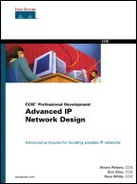Distribution Redundancy
Now that some core designs have been covered, the redundant designs for the distribution layer will be discussed. The distribution layer is covered more thoroughly in Chapter 4, "Applying the Principles of Network Design." Additional issues with redundancy and addressing are discussed in that chapter.
The two most common methods for providing redundancy at the distribution layer are dual homing and backup links to other distribution layer routers. The main consideration when designing redundancy in the distribution layer is unexpected traffic patterns.
Dual Homing to the Core
In Figure 3-8, Router A has two connections to the core through separate routers. While this provides very good redundancy—the loss of a single core router or a single link won't make any destinations behind Router A unreachable—it can also create some problems.
Figure 3-8. Dual Homing in the Distribution Layer

If Router A were connected only to one core router, Router D would have two paths to 172.16.0.0/16:
Router D to Router B to Router A
Router D to Router C to Router B to Router A
With Router A dual-homed to the core, Router D has four paths to this destination:
Router D to Router C to Router A
Router D to Router B to Router A
Router D to Router C to Router B to Router A
Router D to Router B to Router C to Router A
Dual homing Router A to the core effectively doubles the number of paths available to 172.16.0.0/16 in the core. This doubling of possible routes for every dual-homed distribution layer router slows network convergence.
It's sometimes possible to force the metric or cost of one of the two paths to be worse so that traffic will normally flow over only one link. The number of paths is still doubled, so this isn't a very effective solution for advanced routing protocols. A better solution would be to only advertise 172.16.0.0/16 over one link unless that link becomes unusable. Conditional advertisement and floating static routes can be used to only advertise a route when necessary.
Dual homing also presents one other problem: If the link between Router B and Router C goes down, Router A could be effectively drawn into a core role, passing transit traffic between Router B and Router C. This may be a valid design if it's anticipated and planned for, but it's generally not. The easiest way to prevent this from occurring is to configure Router D so it doesn't advertise routes learned from Router C back to Router B, and so it doesn't advertise routes learned from Router D back to Router C.
Redundant Links to Other Distribution Layer Devices
Installing links between distribution layer routers to provide redundancy has the following drawbacks (see Figure 3-9):
Doubling the core's routing table size— As was discussed when looking at dual homing distribution layer devices to the core, adding the link between Router A and Router B in Figure 3-9 doubles the size of the core routing table because Router D now has paths through both Router A and Router C to the 172.16.0.0/16 network.
Possible use of the redundant path for traffic transiting the core— If the link between Router D and Router C fails in Figure 3-9, it's possible that Router D could begin forwarding traffic to Router A, which is destined someplace beyond Router C, rather than forwarding the traffic to Router E. Router A and Router B can be effectively drawn into a core routing role.
Preferring the redundant link to the core path— Distribution layer routers may end up preferring the redundant path through the distribution layer, rather than the path through the core. In Figure 3-9, it's possible that Router B would prefer the redundant link to the path through the core to reach the 172.16.0.0/16 network.
Routing information leaks— Routing information will leak between the distribution layer branches because the routers in one branch will need to be able to advertise the destinations in another branch as reachable through the redundant link. In Figure 3-9, this can result in instabilities occurring beyond Router A and spreading through all the distribution layer branches, rather than being contained. It can also slow convergence time because routing tables in the distribution layer routers become larger.
Figure 3-9. Redundant Links between Distribution Layer Devices

